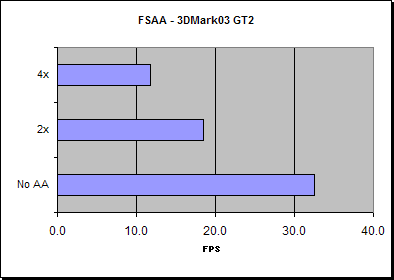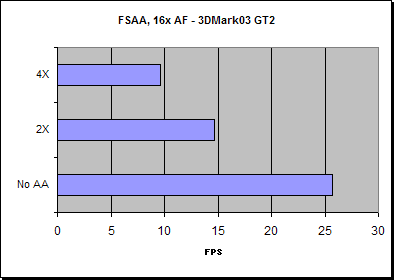Anisotropic Filtering and FSAA Performance
Here we'll look at the performances of the other models of Anisotropic Filtering and FSAA available on the GammaChrome S18 using 3DMakr03's Game Test 2.

| AF (FPS) | 1x | 2x | 4x | 8x | 16x |
| S18 Nitro | 32.5 | 30.7 | 29.2 | 27.8 | 25.7 |
| % Difference from | 2x | 4x | 8x | 16x |
| 1x | -5.5% | -10.2% | -14.5% | -20.9% |
| Previous | -5.5% | -4.9% | -4.8% | -7.6% |
In this test, going from 1x AF to 16x AF accounts for a 21% performance hit. Here the largest single performance drop from one mode to the next is from 8x to 16x AF, which is curious because there should be fewer textures that require the full 16x AF hence this should logically be the smallest performance drop.

| FSAA, Optimal Filtering (FPS) | No AA | 2x | 4x |
| S18 Nitro | 32.5 | 18.5 | 11.8 |
| % Difference from | 2x | 4x |
| No AA | -43.1% | -63.7% |
| Previous | -43.1% | -36.2% |
With a SuperSampling mechanism 2x FSAA doubles the total render load, whilst 4x FSAA quadruples it - in this instance we can see that the performance impacts are close to living up to that theory, although they do both come in a little below. Its interesting to note that moving from 2x FSAA to 4x causes a smaller hit than from no AA to 2x.

| FSAA, 16X AF (FPS) | No AA | 2X | 4X |
| S18 Nitro | 25.7 | 14.7 | 9.6 |
| % Difference from | 2X | 4X |
| No AA | -42.8% | -62.6% |
| Previous | -42.8% | -34.7% |
Using 16x AF in conjunction with the FSAA mode the relative performance impacts fro enabling FSAA don't change much, although there is a few FPS reduction in average performance.
